WINNIPEG – It is, federal agriculture minister Ralph Goodale said, a “stunning statistic.”
Farming, responsible for an estimated 200 accidental deaths per year in Canada, is the country’s most dangerous industry.
Federal and provincial agriculture ministers have agreed to give farm health and safety issues a higher priority and to consider funding an education program.
They were reacting to a pitch for support and recognition made at their annual summer meeting by Dr. Jim Dosman, president of the Canadian Coalition for Agricultural Safety and Rural Health.
Read Also

U.S. bill could keep out Canadian truckers
The Protecting America’s Roads Act, which was tabled in the U.S. House of Representatives at the beginning of October, would “rid the country of illegal immigrant commercial truck drivers and ineligible foreign nationals.”
Dosman, from the Centre for Agricultural Medicine at the University of Saskatchewan, told the ministers there is an unrecognized health and safety crisis in agriculture.
Part of it is a lack of education, part of it is a lack of standards and also the nature of the industry, made up of several hundred thousand small businesses.
Farmers often work when they are tired and accidents are more likely to occur.
The annual toll in dust or chemical-related illness, machinery-related injuries or deaths is staggering. Those under 20 and those over 65 are the highest-risk groups.
“People are killed or injured in agriculture at a far higher rate than in any other industry,” Dosman said in an interview after his presentation to ministers.
“It is a great way of life but there are hazards.”
The coalition recommended a national strategy that would include improved data collection, better education, creation of farm and rural health advisory committees in each province, an onus on farmers to create safe working conditions and an onus on equipment manufacturers to adhere to safety standards in design.
It would include encouragement to the provinces to develop licensing requirements and training for those using chemicals.
And there would be a national farm health and safety training strategy, developed by industry, farmers and governments.
Money required
All of this would require some government money and co-ordination but not necessarily legislation, regulations or inspectors, said Dosman.
“We stayed away from the regulatory,” he said. “You are not going to put an inspector on 280,000 farms.”
Federal and provincial ministers agreed it is an important issue that should be pursued for the next year, including a study of whether money might be made available from federal agriculture adaptation funds.
There will be a progress report at next year’s meeting in Newfoundland.
“Farm health and safety is an organizational, management and attitudinal issue that can best be managed in Canada by a well-co-ordinated program aimed at creating a safe workplace,” the ministers agreed in a statement.
















